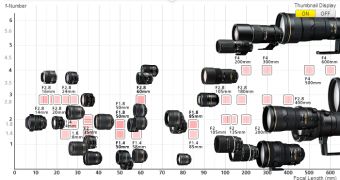Nikon is one of the most influential digital camera and optics manufacturers in the world, and last year's sales figures show just that. Recently, the company announced that the total production of NIKKOR lenses for interchangeable lens cameras had reached 85 million units.
That sounds quite amazing if we take into consideration that the first Nikon 1 mirrorless cameras (the V1 and J1 models) were released just a couple of years back, in October 2011. Since then, the company has continuously tried to improve its MILC technology to give customers a wide range of features similar with Nikon's entry-level digital SLR cameras.
After the release of Nikon 1 V1 and J1, the firm introduced the V2 and J2 models a year later, featuring an improved image sensor, better AF capabilities, and higher shooting rate in burst mode.
The previous year saw even more Nikon 1 camera announcements, including J2's successor (J3) and a low-cost model (Nikon 1 S1) aimed at low-end consumers. In September 2013, the company revealed its first waterproof and shockproof mirrorless interchangeable lens camera, the Nikon 1 AW1.
Currently, Nikon's NIKKOR mirrorless lens lineup consists of 11 models including 6 standard zoom lenses, 3 fixed focal length and 2 waterproof / shockproof optics especially designed for the AW1 camera model.
In September 2013, the company deployed a new measurement device called Optical Performance and Total Image Analyzer (OPTIA), capable of providing accurate data on all forms of aberrations that can occur in mirrorless lenses.
Using OPTIA and a dedicated image simulator, Nikon has improved the quality of its interchangeable lenses, providing better control over resolution and lens development.
Recently, the company unveiled its latest entry-level digital SLR, the D3300, along with a new 18-55mm f/3.5-5.6G VR II kit lens. The Nippon manufacturer is also working on a successor (D4s) for the company's flagship DSLR camera, the D4.

 14 DAY TRIAL //
14 DAY TRIAL //